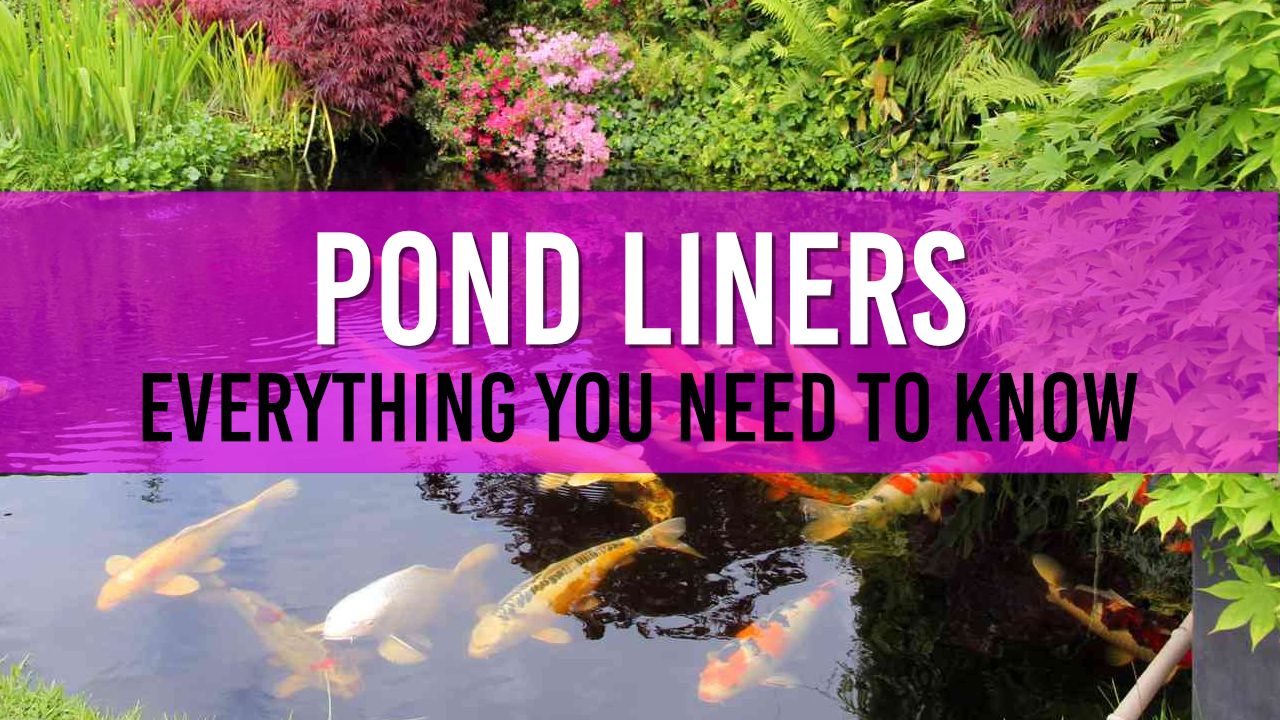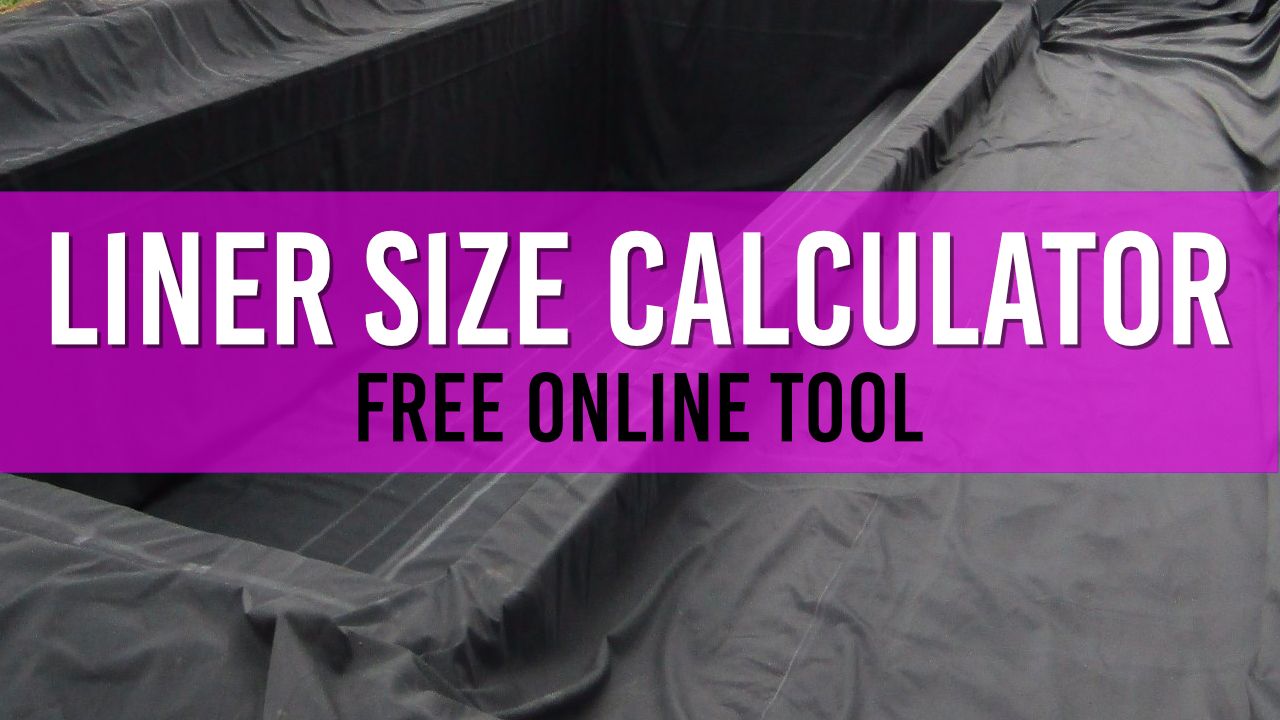Pond Liners - Everything you need to know
Learn all about Pond Liners, what they are used for, will you need an underlay and whether it's better to choose a premade liner, or make your own unique shape garden pond.

Table of Contents
Pond liners are essential for creating and maintaining a healthy and vibrant garden pond. They provide a watertight barrier to prevent water loss and preserve the pond's ecosystem.
Pond liners come in various materials, thicknesses, and sizes, and choosing the right one can make a significant difference in the pond's long term durability, performance, and overall appearance.
In this article, I'll take an in-depth look at pond liners, covering everything from what they are and their benefits, to their ideal thickness, underlay requirements, and alternative options you can use instead.
What are Pond Liners?
Pond liners are impermeable, flexible materials used to create a water-tight barrier in the construction of ponds, water gardens, or artificial lakes. They play a crucial role in preventing water loss through seepage into the surrounding soil, thus maintaining the desired water level and preserving the pond's ecosystem.
Pond liners can be made from various materials, such as:
- Polyvinyl chloride (PVC)
- Rubber
- Polyethylene
The choice of material depends on factors like durability, flexibility, ease of installation, and environmental impact.
What are the benefits of Pond Liners?
It goes without saying that any pond (which is not pre-formed) will have a liner sitting beneath the waters surface. Pond Liners not only allow the pond to retain water, but also ensures that roots / stones and other materials do not come into contact with your fish.
Even in areas of natural clay where a pond liner may not be necessary, they are still used to protect aquatic life (fish, frogs etc) from toxins from the surrounding ground, and to ensure water does not "seep" into the ground.
Pond Liners also give you the freedom to design any shape pond you want. So if you want a crazy shaped unique pond - you can achieve this by using a pond liner.
What is a good thickness for a pond liner?
A good thickness for a pond liner is around 0.6mm-1mm. This ensures that the liner will not be easily ripped or punctured by roots, stones or any debris that may fall into your pond.
Choosing the right thickness now will potentially save you from a lot of work in the future. Pond Liners are usually available in 2 categories of thickness:
- Standard Pond Liners: 0.3mm to 0.5mm
- Premium Pond Liners: 0.6mm to 1.2mm
Whilst "standard" pond liners are cheaper to purchase online, they often do not last as long as premium liners and will need to be replaced sooner.
Do pond liners need underlay?
While pond liners are designed to provide a watertight barrier for ponds, it is highly recommended to use an underlay to enhance their performance and longevity.
What is a Pond Liner underlay?
An underlay is a layer of material, often a geotextile fabric or thick padding, that is placed between the pond liner and the excavated pond surface. The primary function of an underlay is to protect the pond liner from punctures or damage caused by sharp objects, roots, or stones in the soil.
Pond Underlays also help to distribute the weight and pressure of the water evenly, preventing the liner from stretching or sagging in certain areas.
What can I use instead of a rubber/plastic pond liner?
If you're looking for alternatives to traditional pond liners, there are several options you can consider for creating a watertight pond. Some of these alternatives may have limitations in terms of durability or ease of installation, but they can still be effective depending on your specific needs and preferences.
- Bentonite clay: This natural clay has the ability to expand when wet, creating an impermeable barrier when applied to the pond's bottom and sides. Bentonite clay can be mixed with soil or applied in layers to form a natural, eco-friendly pond lining. However, this method might not be suitable for all soil types and may require periodic maintenance.
- Concrete or cement: Constructing a pond with concrete or cement is another option for those looking for a more permanent and durable solution. This method involves pouring and shaping concrete to form the pond's structure. While it can be long-lasting, it may not be as flexible in terms of design, and it can also be labour-intensive and costly.
- Natural pond: Creating a natural pond involves using the existing landscape, soil, and plants to retain water. This option requires careful planning and selection of an area with suitable soil composition, such as clay-rich soil, which can naturally hold water. The pond may need regular maintenance, and water levels can be less predictable than with lined ponds.
- Preformed pond shells: These are rigid, pre-shaped pond basins made from materials like fiberglass or high-density polyethylene (HDPE). They come in various sizes and shapes and can be simply placed into a suitably excavated hole. However, they may lack the design flexibility of pond liners and can be more prone to cracking over time.
Do preformed ponds require a pond liner?
Preformed ponds, which are rigid, pre-shaped basins made from materials like fiberglass or high-density polyethylene (HDPE), do not typically require a pond liner.
They are designed as self-contained, watertight units that can hold water without the need for an additional barrier. To install a preformed pond, you simply need to excavate a hole that matches the shape and size of the preformed shell and then carefully place the shell into the hole, ensuring it is level and stable.
While preformed ponds do not need a separate pond liner, I would still recommended to use an underlay beneath the preformed shell. The underlay, made of a geotextile fabric or thick padding, will protect the shell from potential damage caused by sharp objects, stones, or roots in the soil.
Should I buy a preformed pond?
Deciding whether to buy a preformed pond depends on various factors, including:
- Your desired pond size
- Pond Shape
- Budget
Preformed ponds, made from rigid materials like fiberglass or high-density polyethylene (HDPE), offer several advantages, such as:
- Ease of installation
- Long Term Durability
- Watertight structure
- Quicker to install when compared to Pond Liners
Preformed Ponds come in a variety of predetermined shapes and sizes and are generally more suitable for small to medium water gardens.
What's wrong with Preformed Ponds?
Preformed ponds may not provide the same level of design flexibility and customization as flexible pond liners, which can be shaped to fit any pond configuration.
Preformed Ponds are more expensive when compared with a liner of the same size.
Cheaper "thinner" preformed ponds are often prone to cracking over time due to environmental factors or ground movement. Moreover, preformed ponds may have a higher upfront cost compared to pond liners.
What size pond liner do I need?
I've written a separate page for this which allows you to enter the width, length and depth (or height if you have a raised pond) and the tool will automatically calculate the correct sized liner for your needs.

I need some advice about a Pond Liner
I am more than happy to help with your Pond Liner questions. Please either contact me, or leave a comment below.


